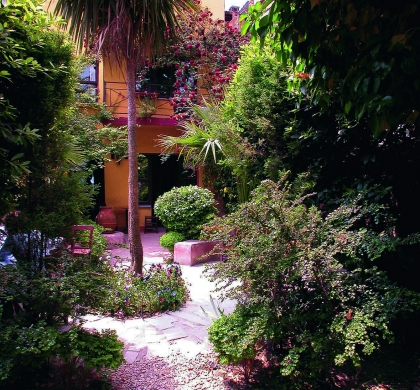Buy or gift a stand-alone digital subscription and get unlimited access to dozens of back issues for just £18.99 / $18.99 a year.
Please register at www.exacteditions.com/digital/cornucopia with your subscriber account number or contact subscriptions@cornucopia.net
Buy a digital subscription Go to the Digital EditionThe first of Sinan’s great sultanic mosques, built between 1544 and 1555 as a memorial to Süleyman the Magnificent’s son.
The first element of the complex to be built was the young Mehmed’s octagonal türbe (mausoleum), at the back of the mosque. In the Koranic verses inscribed between the windows, the name Muhammed, the Arabic version of Mehmed, appears at every opportunity. A jewel casket of a building, both this türbe and the tiled tomb of the grand vizier Rüstem Pasha next to it are sadly rarely open.
The decorative detailing of the mosque continues throughout the exterior of the mosque, and into the beautifully compact courtyard, the ideal spot to admire the gorgeous minarets. The interior is relatively gloomy. Sinan had a long way to go, but this was, after all his first grand mosque.
THE SÜLEYMANIYE 1544–55
The Süleymaniye towers over the Golden Horn, on a phenomenal man-made terrace, surrounded by a lush green outer courtyard crisscrossed with diagonal paths, and with shady plane trees in the corners. On the northern side, a magnificent esplanade looks down a cascade of medrese domes to the Golden Horn, the Bosphorus and the Topkapı Palace. The complex has recently been restored, and the ashlar stone is a little too pristine – no doubt time will soften it.
Sinan only came to mosque-building in his fifties. He would build more than 100 complexes over the next four decades, as well as numerous bridges and aqueducts even more costly than the grandest mosques.
The Süleymaniye is the most imposing of Sinan’s three great imperial mosques, though he dismissed it as his ‘journeyman work’. It shares a hilltop with the Şehzade Mosque, his ‘apprenticeship” (page 96); the Selimiye in Edirne (1568–74), his ‘masterwork’, is an easy day’s outing by bus.
Work began on the mighty Süleymaniye in 1548, as soon as the Şehzade, built for Süleyman the Magnificent as a memorial to his late son, was completed. Süleyman had cause to celebrate: with the Holy Roman Emperor forced to sue for peace in Hungary, the tenth Ottoman sultan assumed the mantle of Roman Emperor. And after a victory over the Safavid Shah Tahmasp of Persia – who agreed to stop cursing Sunni caliphs at prayer time – he could justifiably claim the title of universal sultan and caliph. In Turkish Süleyman is Kanunî, ‘the Lawgiver’. It was time for a ‘Temple of Solomon’…
RÜSTEM PASHA MOSQUE 1561–63
To luxuriate in Iznik tilework from the height of its golden age, take the unpromising stone stairs up to the Rüstem Pasha Mosque in Tahtakale, in Eminönü’s bustling markets, ducking low to avoid the iron rivets. In 1563, Sinan’s contemporaries must have been amazed. Tiles had never been seen in a grand vizier’s mosque, and were never seen again on this scale. A fitting memorial to Süleyman the Magnificent’s grand vizier, son-in-law and financial genius, from Mihrimah, his wife. The location of the mosque at the commercial heart of the empire was no accident.
Seen from the sea, the dome floats in the shadow of his master’s mosque. In the street outside, you are unaware of its existence – two doorways are the only clues. This is another of Sinan’s visual tricks. Climb to the terrace to enjoy the blaze of colour indoors…
ŞEHZADE MEHMED MOSQUE 1544–55
In her book The Age of Sinan Gülru Necipoğlu describes the first of Sinan’s great trio of sultanic masterpieces as a mosque ‘to defeat grief’. The Şehzade is a memorial to Süleyman the Magnificent’s heir, ‘the most distinguished among princes, my son Mehmed”. This was a chronogram penned by Süleyman, whose characters deliberately added up to the year of his son’s death, 1543.
The şehzade (crown prince) had died at 22 when his father was on his way back from a victorious campaign in Hungary. For two-and-a-half hours the sultan wept by his grave beside the Divan Yolu, the street leading past the mosques of his forebears; for 40 days, clad in black, he attended prayers.
Sinan was given the task of commemorating the prince in 1544; though well past his 50th birthday, he had barely begun his 40-year career as chief royal architect. A proven engineer, he pulled down part of the aqueduct to ensure the mosque could be seen across the Golden Horn: a siphon kept the water flowing.


 Issue 67, December 2024
Beauty in the Wilderness
Issue 67, December 2024
Beauty in the Wilderness

Cornucopia works in partnership with the digital publishing platform Exact Editions to offer individual and institutional subscribers unlimited access to a searchable archive of fascinating back issues and every newly published issue. The digital edition of Cornucopia is available cross-platform on web, iOS and Android and offers a comprehensive search function, allowing the title’s cultural content to be delved into at the touch of a button.
Digital Subscription: £18.99 / $18.99 (1 year)
Subscribe now